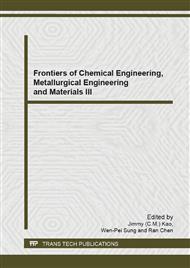[1]
K. Hagelstein, Globally sustainable manganese metal production and use, Journal of Environmental Manage- ment 90 (12) (2009) 3736-3740.
DOI: 10.1016/j.jenvman.2008.05.025
Google Scholar
[2]
Liu Shengli: China's Manganese Industry, Vol. 16 (l4) (1998), p.34.
Google Scholar
[3]
Andreo zzi R, Inso la A, Caprio V, et al. The kinetics of Mn (II)-catalysed ozonation of oxalic acid in aqueous solution[J]. Wat Res, 1992, 26 (7): 917-921.
DOI: 10.1016/0043-1354(92)90197-c
Google Scholar
[4]
Ge, X.X., Cai, G.P., Zeng, G.M., 2004. Study on harmless disposal and comprehensive utilization of manga- nese sulfate waste residue. China's Manganese Indust. 22, 11-14.
Google Scholar
[5]
Feng Zhang, Jinying Xi, et. al. Effect of inlet ozone concentration on the performance of a microbubble ozona- tion system for inactivation of Bacillus subtilis spores. In: Separation and Purification Technology, 2013, 114: 126-133.
DOI: 10.1016/j.seppur.2013.04.034
Google Scholar
[6]
Techcommentary: Advanced Oxidation Processes for Treatment of Industrial Wastewater. An EPRI Community Environmental Center Publ. No. 1, (1996).
Google Scholar
[7]
Ma Jun, Graham N J D. Manganese-catalysed ozonation for the destruction of atrazine-effect of humic subst- ances. Water Research, 1999, 33 (3): 785-793.
DOI: 10.1016/s0043-1354(98)00266-8
Google Scholar
[8]
Susan J, Tewalt, Motoaki Sato, et al. Use of ozone to remediate manganese from coal mine drainage water. National Meeting of the American Society of Mining and Reclamation, 2005, 19 (23), 1166-1176.
DOI: 10.21000/jasmr0501166
Google Scholar
[9]
Jun M , Nigel J D G. Degradation of atrazine by manganese-catalysed ozonation: Influence of humic substan- ces. Water Research, 1999, 33(3), 785-793.
DOI: 10.1016/s0043-1354(98)00266-8
Google Scholar
[10]
Rip G. Rice, Paul K. Overbeck, Ken Larson, Ozone treatment of small water systems, International Ozone A association, (1998).
Google Scholar
[11]
Dean Gregory, Kenneth Carlson, Oxidation of dissolved manganese in natural waters, Annual Conference Proceedings, AWWA, (1996).
Google Scholar
[12]
B. Langlais, D.A. Reckhow, D.R. Brink, Ozone in water treatment, AWWA. Research Foundation and Lewis Publishes, (1991).
Google Scholar
[13]
Montaser.Y. Ghaly, Purification of water from organic impurities by advanced oxidation process, PhD Thesis, (2001).
Google Scholar


